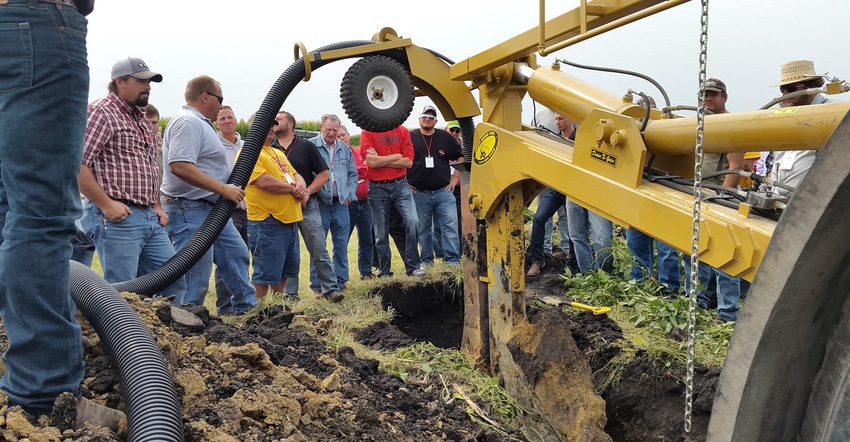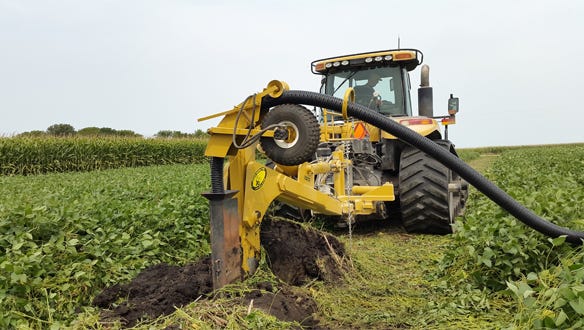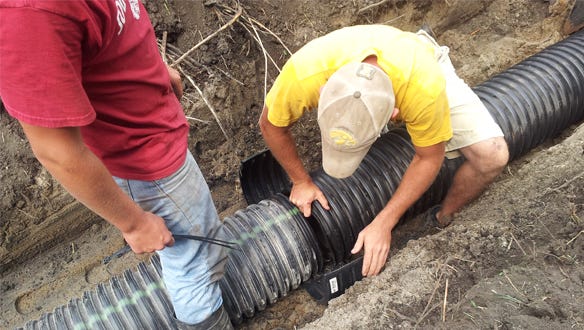March 24, 2017

By Kapil Arora
Subsurface tile drainage systems are used in Iowa and the Upper Midwest to drain excess water from poorly drained soils. Removal of excess water from the plant root zone helps protect crops from excess water damage and allows for timely field operations. Such drainage systems also help reduce in-field crop yield variation and can boost overall yield of a field. Production capacities of Iowa soils can only be optimized with well-designed and properly operating subsurface drainage systems.
Somewhat poor to poorly drained Iowa soils had subsurface drains installed during the late 19th and early 20th centuries to improve productivity. Approximately 35% of Iowa’s agricultural land is considered to be artificially drained, according to USDA’s National Agricultural Statistics Service. A number of these drainage systems are now 100 years old or more, and are in need of upgrading, either with installation of a completely new system or retrofitting.
Key features needing attention when planning a subsurface drainage system include laws, soils and topography, capacity and intensity, installation quality, and environmental considerations. Drainage contractors, engineers and consultants, landowners, farmers, agency staff and others interested in subsurface drainage should not only pay attention to these key features, but also develop a comprehensive understanding of how subsurface drainage systems function. Several standards and technical guides can help increase your knowledge. The Iowa Drainage Guide and the ASABE Standard (American Society of Agricultural and Biological Engineers) for design and construction of subsurface drains are examples of additional information helpful when learning about the art and science of designing and installing subsurface drains.
Follow the law
Land from where water is removed is typically called the “dominant land,” and land that gets the water served to it from the dominant land is called the “servient land.” The majority of lands exist in dual status — being servient to higher-elevation lands and being dominant to lower-elevation lands. Thus, it’s important to understand how the drainage system can accommodate existing and future needs; planning a drainage system with some flexibility can be helpful.
One of the preliminary steps in planning a drainage project necessitates that all parties involved develop a good understanding of their rights and responsibilities when removing excess water from a dominant land and serving it on to the lower-elevation land.
In addition, it’s important to understand other applicable state laws, local watershed and/or drainage district requirements, as well as federal laws. Farm bills passed by Congress and signed into law in 1985, 1990 and 1996 have created mandates and restrictions specific to wetlands that must be abided by for all subsurface drainage projects.
Soils and topography
Landowners and farmers, working with the fields, typically have a good understanding of how different soils in the field have behaved for drainage over the years. Web Soil Survey (WSS) and Soil Web are two free online tools available to obtain soil data specific to drainage properties of the soils and area to be drained. Both tools are capable of providing the type of naturally occurring drainage by individual soil map units. Naturally occurring drainage information for different Iowa soils is also available in the Iowa Drainage Guide.

WHY DRAIN? Planned installation of a subsurface drainage system can help protect crops from excess rain events, improve crop productivity, reduce yield variation in a field and provide for more timely field operations.

Location and elevation of the outlet for the subsurface drainage system plays a critical role in planning. The location helps to decide what different layouts can be adapted to a field, based on its topography. An evaluation of the topography of the field helps determine potential challenges posed by high and low spots, and how a particular layout can be a better fit. Freely available LiDAR maps for Iowa, with 2-foot contour intervals, can be used to assess the topography of a given field, though software capable of reading georeferenced maps is needed. Topographic contour maps can also be developed with use of laser or accurate GPS equipment. Contour elevations in conjunction with the outlet elevation can help assess slope or grade available for a drainage system layout.
Capacity and intensity
A subsurface field drainage system typically consists of laterals connected to a main pipe. Purpose of these laterals and the main is to remove excess water from the upper root zone area within 48 to 72 hours following an intense rainfall event. The capacity of the system should be planned so it provides for an adequate amount of water removal on a daily basis. This per-day water removal amount is referred to as the “drainage coefficient” and has a typical value of three-eighths to a half inch of water removal per day for mineral soils under row crop production. This number can be different for high-value crops or organic soils, or if surface inlets are attached to the drainage system.
The drainage coefficient along with area to be drained determined from the WSS can be used to determine the outlet capacity, and subsequently the diameter of the main.
The amount of water a drainage pipe can convey under full pipe-flow conditions depends on the slope or grade at which the pipe is installed, material of construction and shape, and its inside diameter. Graphs, slide rules and online calculators are available to determine the full pipe-flow capacity for different diameters, grades, and pipe shapes and materials (corrugated or smooth, polyethylene or concrete, etc.). Using these tools, a pipe size can be selected that’s close to the capacity determined using the drainage coefficient and area to be drained by the pipe.
In addition to pipe capacity, the grade or slope of the installed pipe should be so selected that the water flowing in the pipe maintains a minimum flow velocity. Minimum flow velocity is essential so the system carries any sediment with the flow and does not allow it to settle out in the system. Excessive flow velocities can potentially cause pressure problems at pipe joints, which can cause erosion to occur around the joint. This can cause the eroded sediment to flow into the system or the joint to become unstable. Caution should be exercised to select the installation grade so the flow velocities do not become excessive. Minimum and maximum flow velocities based on grade and soil types are available in the Iowa Drainage Guide.
Drainage intensity refers to depth and spacing of laterals that capture excess water and convey it to the main. Laterals installed closer at the same depth rather than farther apart can cause the drainage coefficient to be higher, with other factors staying the same. A higher drainage coefficient can result in an undersized main. Spacing should be adequate to result in relatively uniform drainage across the field. Factors such as surface drainage, soil permeability, soil stratification, drainage coefficient and depth of installation should be considered when deciding what spacing of tile lines to use for a specific site. Installing laterals too close together can significantly increase costs, resulting in reduced gains.
Installation quality
Experienced installers who understand the limits and capabilities of their equipment are an absolute necessity for achieving good-quality installation. Installation equipment should create bedding at the bottom of the trench to maintain proper pipe structural stability. Soil in the bottom of the trench needs to support the buried drainage pipe.

DETAILS: Proper alignment and use of connectors can result in well-functioning drainage systems. Special care should be taken to ensure that every installation is on grade and of high quality. Because quality installation is important, an experienced installer is an asset.

Compacted soils and rocks may pose installation issues to certain installation equipment. Under such conditions, caution should be exercised to achieve uniform grade with no back-fall. Connectors should be used when connecting laterals to one another and when connecting laterals to the main. Connections should be made on stable soil, and overexcavation of the support soil should be avoided.
When discharging the water from the main into a county ditch or a creek or stream, you need to assure good outlet conditions so the support soil around the outlet does not erode over time. Consider installing a rodent guard at the outlet to prevent future plug-ups. Use of design factors explained earlier, along with a quality installation, can help keep a drainage system functional for a number of years.
Environmental considerations
Subsurface drainage of wet and saturated soils helps to remove excess water, thus reducing plant stress by allowing aeration of the plant’s root zone. This excess water removal from the subsurface of agricultural fields allows soils to enhance their productivity. The excess water has the potential to carry nitrate-N, one of the forms of nitrogen the plant takes up when it absorbs water through its roots. Nitrate-N is essential for plant growth; however, its loss with subsurface drainage water can potentially lead to water quality problems.
Practices that help to reduce the amount of nitrate-N lost from farmland need to be considered when planning a drainage system to reduce the water quality impacts. Several practices that can be considered include wetlands, bioreactors, controlled drainage, saturated buffers, shallow drainage, reduced drainage intensity, and winter forage or cover crops. Each of these practices has its performance capabilities for removing nitrate-N from drainage water based on how well it fits into the topography of the field and the amount of drainage water it is able to treat.
When addressing water quality improvements for subsurface drainage water, no one practice may be able to achieve the desired reductions. A combination of both in-field and edge-of-field practices will be needed at field-scale, sub-watershed scale and watershed scale. A comprehensive approach for reducing nutrients, as outlined in the Iowa Nutrient Reduction Strategy, can deliver a better impact in reducing nitrate-N concentrations and loads in subsurface drainage water.
Additional information on planning and designing a drainage system can be obtained from the Iowa Drainage Guide, available through ISU’s Extension Distribution Store. ISU conducts farmland drainage workshops and an Iowa Drainage School for stakeholders interested in farmland drainage. The next Iowa Drainage School is scheduled for Aug. 22-24 at Nashua. Additional details about the school are available at aep.iastate.edu/ids.
For more information on farmland drainage, visit agwatermgmt.ae.iastate.edu and extension.umn.edu/agriculture/water.
Arora is an agricultural engineering field specialist with Iowa State University Extension and Outreach. He can be reached at [email protected].
You May Also Like




